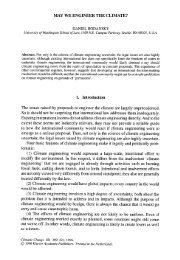ThorEA - Towards an Alternative Nuclear Future.pdf
ThorEA - Towards an Alternative Nuclear Future.pdf
ThorEA - Towards an Alternative Nuclear Future.pdf
You also want an ePaper? Increase the reach of your titles
YUMPU automatically turns print PDFs into web optimized ePapers that Google loves.
4.3 The patent l<strong>an</strong>dscape<br />
Categorization of the technological fields outlined in a patent<br />
<strong>an</strong>d the field for which the rights of monopoly are claimed is<br />
known as the International Patent Classification (IPC). The<br />
International Patent Classification G21C “<strong>Nuclear</strong> Reactors”<br />
covers a wide r<strong>an</strong>ge of techniques for designing, building <strong>an</strong>d<br />
operating nuclear systems, especially for commercial power<br />
stations, but additionally for military, maritime <strong>an</strong>d space<br />
scenarios. The classification also tends to be applied to a<br />
scattering of other nuclear related disciplines such as clinical<br />
nuclear therapies. (See Figure 11).<br />
The scale of the patent literature in the G21C area c<strong>an</strong><br />
be judged from a cursory look at this classification using<br />
the widely known Esp@cenet service (highlighted in the<br />
Appendices), which indicates that a little over 100,000 patent<br />
families have been filed in this area over the past few decades.<br />
The rate of patenting in this area peaked around 1985, when<br />
over 4000 separate patent families were published, so the<br />
majority of patents gr<strong>an</strong>ted will now have expired, but the rate<br />
remains at a respectable 1500 or so new patent families being<br />
published each year as 2010 approaches.<br />
The Number of Patents the International Patent Classification G21C<br />
“<strong>Nuclear</strong> Reactors” containing keywords<br />
G21C + Thorium + Fuel<br />
G21C + Accelerator<br />
G21C + Tr<strong>an</strong>smutation<br />
G21C + Thorium + Waste<br />
G21C + Superconducting<br />
G21C + Spallation<br />
G21C + Proton Beam<br />
C<strong>an</strong>cer or Therapeutic; Thorium<br />
G21C + Thorium + Fissile<br />
G21C + Linear Accelerator<br />
Thorium + Military<br />
G21C + Linac<br />
0 20 40 60 80 100 120 140 160<br />
Number of Hits<br />
Figure 11. International patents related to <strong>Nuclear</strong> Reactors <strong>an</strong>d<br />
other ADSR components.<br />
The home countries for each patent family, as judged by the<br />
country of the priority application, follow trends in other<br />
technologies. For 2008 publications, Jap<strong>an</strong> dominates G21C<br />
with 386 families, followed by the US with 329. Fr<strong>an</strong>ce (151),<br />
South Korea (142), China (105), Russia (95) <strong>an</strong>d Germ<strong>an</strong>y<br />
(85) follow behind. Korea <strong>an</strong>d China are both relatively new<br />
players in this patent field <strong>an</strong>d indeed on the international<br />
patent stage in general, but both have a very signific<strong>an</strong>t<br />
future potential.<br />
As for most fields of technology, the patent families in G21C<br />
tend to be dominated by modest engineering developments<br />
of well established schemes. Thorium, which is little used<br />
commercially at present, is mentioned in the title or abstract<br />
of only about 380 of the patent families ever categorised in<br />
G21C <strong>an</strong>d “accelerator” in only about 70. The International<br />
Patent Classification also provides us with a very useful<br />
subcategory of “subcritical reactors” G21C1/30, into<br />
which the proposed thorium-fuelled ADSR would fall, <strong>an</strong>d<br />
historically this categorisation has been assigned to a total<br />
of about 1200 patent families. Of these, m<strong>an</strong>y relate to fuel<br />
preparation <strong>an</strong>d processing. Probably less th<strong>an</strong> ten of these<br />
families contain discussions of thorium, while around twice<br />
that number contain discussion of particle accelerators.<br />
Signific<strong>an</strong>t in this context is the Energy Amplifier (ADSR)<br />
patent filed by Nobel Laureate Carlo Rubbia in 1993. This<br />
patent is discussed in detail in Appendix VI. However it is<br />
noted that the Rubbia patent was initially brought into<br />
effect in twelve Europe<strong>an</strong> countries, but most of these<br />
national patents were allowed to lapse in 2003, with only<br />
Fr<strong>an</strong>ce, Belgium <strong>an</strong>d Italy remaining. The term of a patent is<br />
twenty years from the filing date, so these remaining patents,<br />
<strong>an</strong>d <strong>an</strong>y others of the family remaining in force, will expire by<br />
about 2014. There is little prospect of Rubbia’s system being<br />
incorporated in a working Power Station by that time. This<br />
reflects a difficulty for early concept patents in fields, such<br />
as nuclear power, where the timescales for accept<strong>an</strong>ce <strong>an</strong>d<br />
eventual implementation are long.<br />
A report prepared by: the thorium energy amplifier association 33



